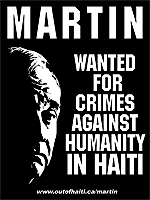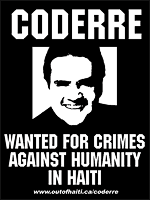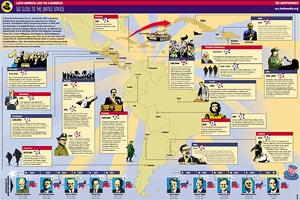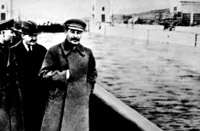haiti
 The Society of Typographic Aficionados is calling for designers to submit a black and white "ampersand" icon to build a collaborative font that will be sold to raise funds for relief efforts in Haiti. Previous Font Aid fonts have benefitted UNICEF to help war and disaster refugees, victims of the September 11 tragedies in the US, and relief efforts in countries affected by the Indian Ocean earthquake and tsunamis.
The Society of Typographic Aficionados is calling for designers to submit a black and white "ampersand" icon to build a collaborative font that will be sold to raise funds for relief efforts in Haiti. Previous Font Aid fonts have benefitted UNICEF to help war and disaster refugees, victims of the September 11 tragedies in the US, and relief efforts in countries affected by the Indian Ocean earthquake and tsunamis.Update 3/21/2010: the open source project Ushahidi has had some good press lately about its role in the Hatian and Chilean earthquake relief efforts, mapping the crisis and response with text-messages.
Canada Out of Haiti!
Reader dru writes in about this graphic campaign around the upcoming elections in Canada:
“In February 2004, Canada backed a coup that removed Haiti’s democratically elected president (Aristide) and the entire elected government. Since then, they’ve been training police that have been shooting demonstrators, and propping up a ‘justice’ system that is systematically jailing political dissidents (the ones that aren’t in hiding or dead).
A bunch of Haiti solidarity activists are trying to unseat the Foreign Minister, Pierre Pettigrew (who had a brief cameo in The Corporation as a corrupt international trade minister), who played a key role (and continues to) in backing the post-coup government.
In the last election, he won by a very small margin in his riding of Papineau in north Montreal, which has a high population of Haitians.
In conjunction with groups in the Haitian community there, we're waging an all-out propaganda battle to unseat Pettigrew. Thousands of these posters: http://outofhaiti.ca/pettigrew/
Similar flyers have been distributed in the riding, and we hope to get a few thousand more out before election day (Jan. 23). Because the riding is such a hotspot, our posters have appeared on two nationally-broadcast TV news shows (in French and English).
Posters have also been created for the Prime Minister and his special advisor on Haiti and are going up in cities all across Canada.”
Read more about the campaign at http://outofhaiti.ca/
Post These Bills
Christopher DeWolf has a nice little editorial on posters and the political struggles around them in a couple of Canadian cities:
“Posters are the city. For community groups, musicians, activists, small businesses, and hell, even people who’ve lost their cat, they’re often the only way to get a message out. They cover lampposts, service doors, construction hoardings and blank walls, livening up grey and depressing winters and turning underused spaces into interactive bulletin boards where the city’s goings-on are announced to anyone who might be interested. Despite their importance to civic and cultural life however, posters are an all-too-easy target for municipal politicians and bureaucrats who want their city streets as bland and orderly as a Lego metropolis. Posters might seem innocuous, but they are in fact a sign of a city’s vitality and diversity — how municipalities deal with postering is a measure of just how willing they are to accommodate that vibrancy.”
DeWolf privileges “freedom of expression” and a “diversity” of voices but I would take it further and say that this is a matter of democracy itself — of ownership of the means of communication and the of the physical space of our communities, of building community and political power.
Rogue State
“An understanding of the current crisis requires a sense of Haiti’s history,” notes Paul Farmer, situating the recent coup squarely into the long, brutal history of U.S. economic and military intervention.
The latest Indypendent expands the story to the rest of Latin America and the Caribbean, and does so graphically with this map of U.S. military intervention in the region from 1950 through 2004. Download the PDF here.
The Indypendent, is the biweekly paper of the New York City Independent Media Center. The map is designed by ILC.iNK.
“ILC.iNK develops pages and up-to-date content specifically directed towards the Hispanic community, designed and illustrated with photographs, illustrations and infographics to captivate readers, and always customized to the general format of your publication and the needs of your advertisers. ILC.iNK is the ideal solution to develop special supplements, features, or regularly appearing sections such as Health, Sports, Children, Travel, Food, Music, etc.”
Haiti, 1919
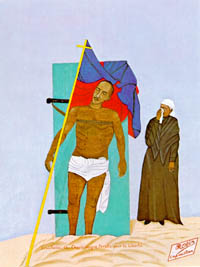 From Noam Chomsky, Year 501: The Tragedy of Haiti, 1993:
From Noam Chomsky, Year 501: The Tragedy of Haiti, 1993:
“The leader of the revolt [against the U.S. invasion], Charlemagne Péralte, was killed by Marines who sneaked into his camp at night in disguise. In an attempt at psywar that prefigured some of Colonel Edward Lansdale’s later exploits in the Philippines, the Marines circulated photos of his body in the hope of demoralizing the guerrillas. The tactic backfired, however; the photo resembled Christ on the cross, and became a nationalist symbol. Péralte took his place in the nationalist Pantheon alongside of Toussaint.”
The photograph was immortalized in 1948 by Philome Obin in his painting, Crucifixion de Charlemagne Péralte pour la Liberté.
Underground Networks
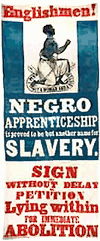 On the power of posters, pamphlets, and petitions in the time of globalization.
On the power of posters, pamphlets, and petitions in the time of globalization.
From “Sailing the Black Atlantic,” by Adam Hochschild, a review of Making the Black Atlantic. Britain and the African Diaspora, in The Times Literary Supplement, October 6, 2000:
“By requiring a complex skein of transport, trade, credit and insurance ties that connected Europe, Africa and the Americas, slavery and the slave trade were the core of the eighteenth century’s version of globalization.
In turn, one might call the black diaspora the era’s Internet. As Walvin points out, it was an information network. Word of the dramatic blossoming of abolitionism in England, for instance, was eagerly carried back across the Atlantic by black sailors, and by black domestics brought back and forth across the ocean by their West Indian masters. Slaves waiting on plantation dinner tables in Jamaica or Barbados listened hard when their owners cursed the do-gooders in Parliament, or the Quakers, who organized a huge boycott of slave-grown sugar. News from each side of the Atlantic affected the other. Reports of hundreds of abolitionist petitions flooding Parliament helped spark some of the revolts among impatient slaves in the Caribbean. The first major uprising, in the French colony of Saint Domingue (later Haiti) in the 1790s, provoked a backlash in Britain against the abolitionists, but a later one, in Jamaica in 1831-2, was crucial in hastening emancipation.”
Underexposed
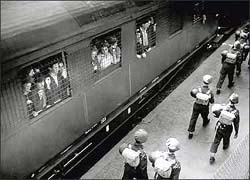 The people in the black and white photo behind the bars of the boxcar in the 1940’s German train station are not Jews off to the camps to be killed. They are indeed German Jews off to a camp, but the photo was taken after the end of war, the soldiers on the platform are British, and the passengers are survivors of Nazi concentration camps, denied entry into Palestine. Here, they are being transported from Hamburg docks to the Poppendorf detention camp.
The people in the black and white photo behind the bars of the boxcar in the 1940’s German train station are not Jews off to the camps to be killed. They are indeed German Jews off to a camp, but the photo was taken after the end of war, the soldiers on the platform are British, and the passengers are survivors of Nazi concentration camps, denied entry into Palestine. Here, they are being transported from Hamburg docks to the Poppendorf detention camp.
The photo and its story are reproduced in Underexposed. From Vision On Publishing:
“Underexposed tells the stories behind the photographs which determine our view of history, providing a reality check on alleged events from the last hundred years and documenting the struggle of the powerful to contend with rival cultural forces of media and information. Reclaimed from the trash cans of the Second World War. From the cruelty of Stalin’s Russia and fundamentalist chaos in Iran to the horrors of the Gulf war and perspectives on September 11th — even Hitler’s preening speech rehearsals come back to argue with his self-made myth. Via disgruntled starlets, ecological destruction and US nuclear tests, Underexposed gathers together some of the most ideologically dangerous photographs ever taken and releases them to haunt the increasingly manipulated, re-touched present.”
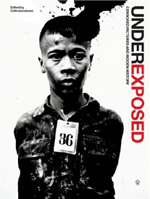 I found the book on the front table at St. Mark’s Books, mixed with the latest compilations on cyber-typography, club flyers, erotica, and graphic novels. The juxtaposition is continued on the publisher’s Web site. Among the publisher’s list of glossy photo books of rock stars, fashion, erotica, and a celebration of the Manchester City Football Club (and its fans), Underexposed seems a bit like war porn. The design of the book is certainly less than sober, full of dramatic, oversized, full-bleed spreads and a hip sans serif typeface. Each photo is provided with some background, but the captions only allow so much space.
I found the book on the front table at St. Mark’s Books, mixed with the latest compilations on cyber-typography, club flyers, erotica, and graphic novels. The juxtaposition is continued on the publisher’s Web site. Among the publisher’s list of glossy photo books of rock stars, fashion, erotica, and a celebration of the Manchester City Football Club (and its fans), Underexposed seems a bit like war porn. The design of the book is certainly less than sober, full of dramatic, oversized, full-bleed spreads and a hip sans serif typeface. Each photo is provided with some background, but the captions only allow so much space.
The bottom line: photographs can lie. Particularly those that purport to be objective. Taken out of context, they are cropped, altered, and framed by the context at hand and by cultural assumptions. And page after page, the flouting of taboo and power starts to flatten out. Like all the speakers in the corner of Hyde Park, all ideologies become equivalent.
That said, the book does rouse a healthy dose of skepticism. It also crosses into the terrain of Barthes’s Mythologies, an examination of connections between language, imagery, ideology, and power and a wandering interrogation of “the obvious.”
From a review in The Guardian:
“In one of the most shocking images, taken from the Sudanese famine of 1984, Wendy Wallace photographed the photographers at work snapping an emaciated child who had been brought out to sit in the dirt precisely for that image.
It is a theme that recurs in Alex Webb’s pictures of the American invasion of Haiti. A line of US troops lies dramatically - heroically - on the Tarmac at Port au Prince airport aiming their weapons at an unseen enemy. Most media organisations showed this image. Webb’s version shows the reality: the only figures are half a dozen and more photographers and cameramen crouched in front of the soldiers, puncturing the dramatic image in a campaign that was to see virtually no opposition to US troops.”
See an excerpt from the forward to the book, some photos from the book, or listen to an audio interview with Colin Jacobson, former photo editor for a number of British news magazines and editor of Underexposed.
...
Also of note, The Commissar Vanishes: The Falsification of Photographs in Stalin’s Russia, an small online exhibit of doctored photos and propaganda posted by the Newseum. Shown here, Stalin with Nikolai Yezhov, commissar of water transport, before and after he was purged.


